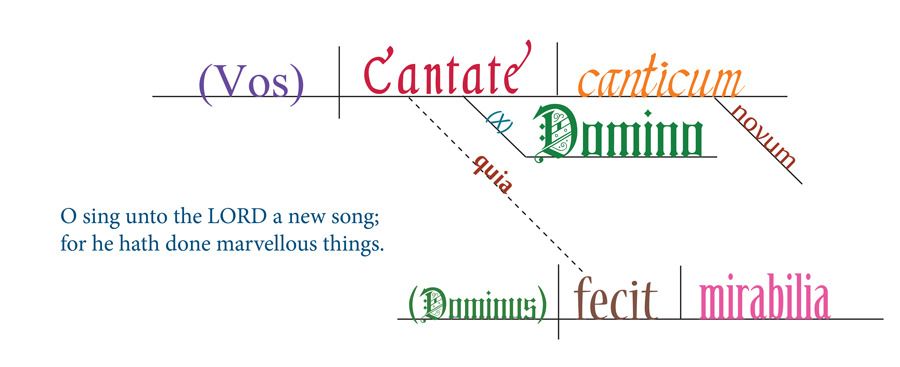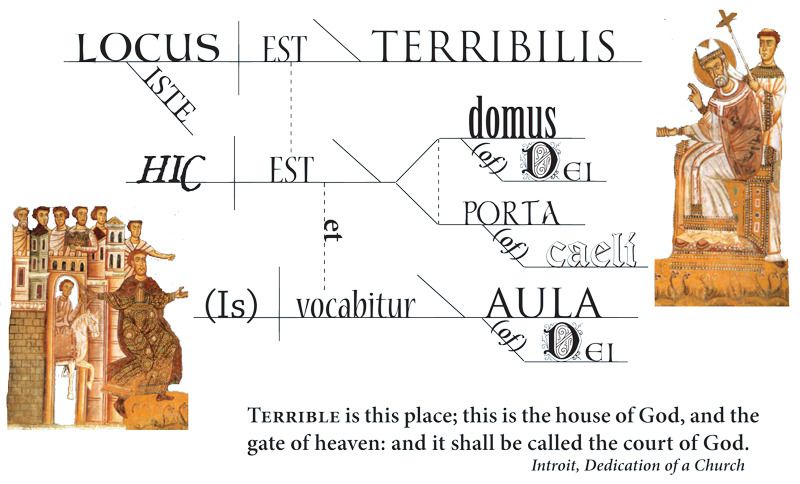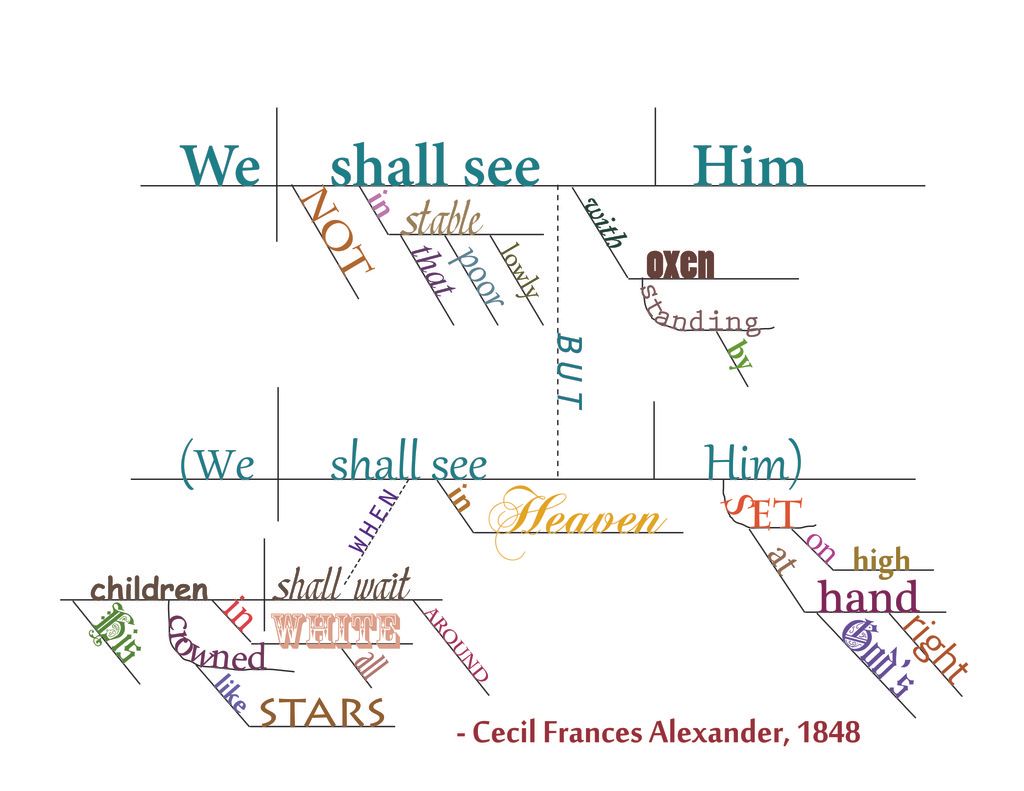My favorite line from Handel's Worthy is the Lamb
-
I was listening to Part III of John Eliot Gardiner's masterful rendition of the Messiah, and this line jumped out at me, so I decided to diagram it for fun:

-
Masterful! I always did have trouble diagramming sentencesThanked by 1JulieColl
-
Brava! Excellent diagram! Classical educator here, LOVE diagrams. And the same sort of parsing can be done to periods and phrases and motives, and can help some of us memorize and/or internalize pieces. Plus there's always the fun of one of one's scholistas saying, 'there's that tone IV lick again' (they got tired of me saying 'motive' and a couple of us like early jazz, so...)Thanked by 1JulieColl
-
How would you diagram the last stanza of 'Once in royal David's city'. This, the entire stanza, is one of my favourite sentences in all hymndom -
Not in that poor lowly stable,
With the oxen standing by,
We shall see him; but in heaven,
Set at God's right hand on high;
When like stars his children crowned,
All in white shall wait around.
- Cecil Frances Alexander, 1848
This, by the way, was written for children, children who we may guess, based upon what they were given to sing and read, were rather brighter, more mature, and more literate than their modern kindred. (Their teachers, too!) -
Love this! Do you have a diagramming program?
-
Brava, brava, brava!
(I hate to be picky, but you left out 'on high' and 'around', and have donated 'for ever'.) -
Ta dah. Now it's fixed, although I'm not happy with the wobbly participle lines.
-
Very pretty - but what is this stuff?
Genuine question...I mean I can see you are splitting out parts of sentences...enlightenment please!Thanked by 1canadash -
If you attended Catholic school before 1965 or so, you understand. Diagramming sentences helped students to understand the parts of speech such as nouns, verbs, adjectives etc., and how to construct a sentence properly.
-
I'm a post 1965 kid, but had to learn this to homeschool my own children if they were to pass grammar, which I never properly learned. I am thoroughly impressed with Julie's skill level here.
Here's a little help: http://www.english-grammar-revolution.com/puzzler_answers.html -
Bonnie, sentence diagramming is a method of illustrating with different types of lines how the elements of a sentence relate to each other.
The straight horizontal line represents the main clause of a sentence. The subject is divided from the predicate by a vertical line that goes through the horizontal line. A straight vertical line after the verb separates the verb from the direct object.
Diagonal lines underneath the main sentence line represent the non-essential sentence elements like adjectives, articles, adverbs, prepositional phrases and participles (which go on curved lines.)
Diagonal dotted lines connect the main clause of the sentence with subordinate clauses, or words with relative clauses, but a vertical dotted line connects two sentences which might be separated by a coordinating conjunction or a semicolon.
There are many more constructions for different parts of speech, but that's the main idea. I like using Mary Daly's The First Whole Book of Sentence Diagrams for paradigms, but there is, as far as I know, no official standard manual of sentence diagrams so you will find some diversity in the constructions.
Here's a pretty cool poster of sentence diagrams of opening lines of famous novels:
http://popchartlab.com/products/a-diagrammatical-dissertation-on-opening-lines-of-notable-novels
-
My recollection of sentence diagrams has faded; grade seven (1969-70) or eight (1970-71) was last contact, and I could not make sense of it.
In college while studying music, I took math department courses which included computer programming and flowchart diagrams and found it easy.
After graduating I worked in software companies and was comfortable with all kinds of diagrams (Yourdon, DeMarco, Page-Jones, Constantine, Hurley, etc).
Maybe I need to revisit sentence diagrams.Thanked by 1JulieColl -
Just for fun and in honor of tomorrow's Introit and next week's Communion antiphon which are for me among the most thrilling of the EF propers.

-
.
-
This is coolest thread ever. I teach diagramming to my kids (and learned it myself in Catholic school some years ago). I also happen to know that genuinely Montessori-trained elementary school children learn to diagram. Maybe all hope is not lost.
As for this:This, by the way, was written for children, children who we may guess, based upon what they were given to sing and read, were rather brighter, more mature, and more literate than their modern kindred. (Their teachers, too!)
Yes indeed, though I'd suggest that children aren't any less potentially bright today; they simply are not asked to be bright. It goes both ways. When you give children complex passages to read, they become more literate, and as they become more literate, they become more able to read complex passages. -
Yes indeed, though I'd suggest that children aren't any less potentially bright today; they simply are not asked to be bright.
THIS CANNOT BE STRESSED ENOUGH.
While I was in the midst of teaching a group of preschoolers to chant in Latin, beginning with the Sign of the Cross, their classroom teacher, who was listening to the lesson, told me that it was above their ability to do that. -
...above their ability...
The one whose ability it was above was the teacher! And it always is.
That goes, too, for choirmasters & priests who tell us that their people can't learn 'that'. -
I still don't really understand what you are doing there, but its is intriguing and lovely.
-
LOL, Bonnie! It's a diagram of the Latin sentence with a main clause, a relative clause and an adverbial clause, as well as various prepositional phrases and a participial phrase. There are many different ways to do it, and it can get kind of crazy. Someone even made an outdoor sentence sculpture in the '70's.
-
Okay Julie, teach us how it works.
Some of us want to be reminded and relearn.
Help me be smarter than a ___-grader! -
Yes, a 'refresher' would be nice. I had trouble with this in the fifth grade, and was glad never to have encountered it again. Odd, isn't it? that most of those things that we thought were not particularly important in our early years turned out to be rather more worthful than our little minds could have thought.Thanked by 1eft94530
-
It does take you back a bit to middle school and high school! Remember old Warriner's Grammar? I had to do diagramming so much in school that it's just automatic now, and it really helps with Latin. I use these diagrams with my children's schola, and it helps them get a sense of things. Here are the basic rules:
The horizontal lines are clauses in the order of Subject/Verb/Direct Object, or Subject/Verb/Predicate Complement.
Horizontal lines contain the most important words: nouns, pronouns, verbs or predicate complements.
The diagonal lines are the ancillary words: prepositions and their objects, adjectives or adverbs. Participles are on curved lines.
The vertical line intersecting with the long horizontal line divides the subject from the predicate. The straight line after the verb indicates a direct object. A slanted line after the verb indicates a predicate complement.
Dotted lines indicate subordinate clauses or another main clause linked by coordinating or subordinate conjunctions.
Here's a really fun one: an understood subject Vos=You all with a compound predicate made up of three verb phrases:
Estote fortes in bello
et pugnate cum antiquo serpento
et accipietis regnum aeternum,
alleluia. -
Warriner's
Oh my goodness.
I have been unable to recall the name of that book for decades.
Just now God answered my prayer. -
Some of us (homeschoolers, for example) still use it!
Thanked by 1MichaelDickson -
Chris! You're being homeschooled?!
-
Unless you mean "taught to be a dad by your children", no, I'm not being homeschooled.Thanked by 1MichaelDickson
-
-
For today's feast, the Dedication of the Archbasilica of St. John Lateran, the Archbasilica of St. John Lateran, the Cathedral of the Bishop of Rome, our "Mother Church", Sacrosancta Lateranensis ecclesia omnium urbis et orbis ecclesiarum mater et caput ( "Most Holy Lateran Church, of all the churches in the City and the world, the mother and head.")

Amazing virtual tour of St. John Lateran here.
Welcome to the MusicaSacra Forum!
To participate in the discussions on Catholic church music, sign in or register as a forum member, The forum is a project of the Church Music Association of America.
Categories
- All Discussions21,108
- General Music Discussion8,218
- Job Openings197
- Management of Music Programs850
- Choral Matters533
- Church Documents and Rubrics524
- CMAA Notes302
- Events716
- For Newcomers: Read First26
- Sacred Polyphony546
- Hymnody872
- Gregorian Chant: General2,698
- ↳ Graduale Romanum and Liber Usualis368
- ↳ Graduale Simplex60
- ↳ Semiology63
- Vernacular Plainsong696
- Anglican Use and Anglican Chant68
- Organ, Other Instruments and Repertoire435
- New Composition/Works in Progress1,291
- Recordings231
- Music for Hispanic Ministry159
- Music Education: Children211
- Music Education: General222
- News Items245
- Positions Wanted2
- General Discussion: Catholicism739
- Amusements177
- General Discussion1,033
- Opinions117





